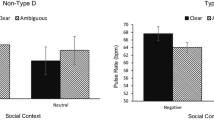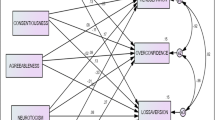Abstract
This study examined whether individuals show self-enhancing tendencies in perceiving their self-esteem and self-protecting tendencies in perceiving their trait anxiety compared with their friends. It also tested whether motivational and/or cognitive explanations account for self-enhancement. Four hundred ten management students from two institutes in India participated. A questionnaire was administered containing socio-demographic information, and inventories of self-esteem, trait anxiety, and tolerance of ambiguity. Inventories with differing instructions assessed the participants’ perception of their friends’ self-esteem and friends’ trait anxiety. Results suggested that individuals perceive themselves to have higher self-esteem and less anxiety than their friends. While males who have low ambiguity tolerance scores increase their self-esteem and decrease their anxiety compared with their perceptions of friends, females who have high ambiguity tolerance scores do not show such self-enhancement. Conclusively, motivated desire of males and their shallow information processing jointly explain the enhancement bias.
Similar content being viewed by others
References
Alicke, M. D. (1985). Global self-evaluation as determined by the desirability and controllability of trait adjectives. Journal of Personality and Social Psychology, 49(6), 1621–1630.
Arkin, R. M., Appelman, A. J., & Burger, J. M. (1980). Social anxiety, self-presentation, and self-serving bias in casual attribution. Journal of Personality and Social Psychology, 38(1), 23–35.
Barnett, J. H., & Karson, M. J. (1989). Managers, values, and executive decisions: an exploration of the role of gender, career stage, organizational level, function, and the importance of ethics, relationships and results in managerial decision-making. Journal of Business Ethics, 8(10), 747–771.
Campbell, W. K., & Sedikides, C. (1999). Self-threat magnifies the self-serving bias: a meta-analytic integration. Review of General Psychology, 3(1), 23–43.
Carr, A. (2004). Positive psychology: The science of happiness and human strengths (Ch.7). Hove: Brunner-Routledge.
Chhokar, J. S. (2013). Leadership and culture in India : The GLOBE research project. Retrieved from http:// http://www.hs-fulda.de/fileadmin/Fachbereich_SW/Downloads/Profs/ Wolf/Studies/india/india.pdf
Clark, L. A., & Watson, D. (1991). Tripartite model of anxiety and depression: psychometric evidence and taxonomic implications. Journal of Abnormal Psychology, 100(3), 316–338.
Collins, J. (2001). Good to great: Why some companies make the leap…and others don’t. New York, NY: HarperCollins Publishers.
Detweiler, R. (1980). Intercultural interaction and the categorization process: a conceptual analysis and behavioral outcome. International Journal of Intercultural Relations, 4(3), 275–293.
Furnham, A., & Ribchester, T. (1995). Tolerance of ambiguity: a review of concept, its measurement and applications. Current Psychology, 14(3), 179–199.
Halvorson, H. G. (2011). Self-serving bias: Why some leaders don’t learn from their mistakes. Retrieved from http://www.huffingtonpost.com/heidi-grant-halvorson-phd/self-serving-bias_b_825072.html
Heine, S. J., & Hamamura, T. (2007). In search of east Asian self-enhancement. Personality and Social Psychology Review, 11(1), 1–24.
Heine, S. J., Lehman, D. R., Markus, H. R., & Kitayama, S. (1999). Is there a universal need for positive self-regard? Psychological Review, 106(4), 766–794.
Hewitt, J. P. (2005). The social construction of self-esteem. In C. R. Snyder & S. J. Lopez (Eds.), Handbook of positive psychology (pp. 135–147). New York: Oxford University Press.
Higgins, N. C., & Bhatt, G. (2001). Culture moderates the self-serving bias: etic and emic features of causal attributions in India and Canada. Social Behavior and Personality, 29(1), 49–62.
Hill, N. C., & Ritchie, J. B. (1977). The effect of self-esteem on leadership and achievement: a paradigm and a review. Group & Organization Management, 2(4), 491–503.
Hofstede, G. (2001). Culture’s consequences: Comparing values, behaviours, institutions, and organizations across nations. Thousand Oaks: Sage publications.
Hooghiemstra, R. (2008). East–west differences in attributions for company performance: a content analysis of Japanese and U.S. Corporate annual reports. Journal of Cross-Cultural Psychology, 39(5), 618–629.
Kahneman, D. (2011). Thinking, fast and slow. New Delhi: Penguin.
Kuler, N. A., MacDonald, M. R., & Derry, P. A. (1983). Parameters of a depressive self-schema. In J. Suls & A. G. Greenwald (Eds.), Psychological perspectives on the self (pp. 191–217). Hillsdale: Erlbaum.
Kunda, Z. (1990). The case for motivated reasoning. Psychological Bulletin, 108(3), 480–498.
Leary, M. R., & Baumeister, R. F. (2000). The nature and function of self-esteem: Sociometer theory. In M. Zanna (Ed.), Advances in experimental social psychology (Vol. 32, pp. 1–62). San Diego: Academic.
Markus, H. R., & Kitayama, S. (1991). Culture and the self: implications for cognition, emotion, and motivation. Psychological Review, 98(2), 224–253.
Marsh, H. W., & Young, A. S. (1997). Causal effects of academic self-concept on academic achievement: structural equation models of longitudinal data. Journal of Educational Psychology, 89(1), 41–54.
Maslow, A. H. (1943). A theory of human motivation. Psychological Review, 50(4), 370–396.
Mezulis, A. H., Abramson, L. Y., Hyde, J. S., & Hankin, B. L. (2004). Is there a universal positivity bias in attributions? a meta-analytic review of individual, developmental, and cultural differences in the self-serving attributional bias. Psychological Bulletin, 130(5), 711–747.
Mishra, S., & Suar, D. (2012). Effects of anxiety, disaster education, and resources on disaster preparedness behavior. Journal of Applied Social Psychology, 42(5), 1069–1087.
Myers, D. G. (2005). Social psychology (8th ed.). Boston: McGraw-Hill.
Pal, G. C. (2007). Is there a universal self-serving attribution bias? Psychological Studies, 52(1), 85–89.
Perloff, L. F., & Fetzer, B. K. (1986). Self-other judgments and perceived vulnerability of victimization. Journal of Personality and Social Psychology, 50(6), 502–510.
Popper, M., Amit, K., Gal, R., Mishkal-Sinai, M., & Lisak, A. (2004). The capacity to lead: major psychological differences between leaders and nonleaders. Military Psychology, 16(4), 245–263.
Robertson, L. S. (1977). Car crashes: perceived vulnerability and willingness to pay for crash protection. Journal of Community Health, 3(2), 136–141.
Rogers, C. R. (1951). Client-centered therapy. New York: Houghton Mifflin.
Rosenberg, M. (1989). Society and the adolescent self-image. Middletown: Wesleyan University Press.
Sarason, I. G. (1975). Anxiety and self preoccupation. In I. G. Sarason & C. D. Spielberger (Eds.), Series in clinical and community psychology: Stress and anxiety (pp. 47–68). New York: Wiley.
Sedikides, C., Campbell, W. K., Reeder, G. D., & Elliot, A. J. (1998). The self-serving bias in relational context. Journal of Personality and Social Psychology, 74(2), 378–386.
Sedikides, C., Gaertner, L., & Toguchi, Y. (2003). Pan-cultural self-enhancement. Journal of Personality and Social Psychology, 84(1), 60–79.
Seligman, M. E. P. (1995). The optimistic child. NewYork: Harper Collins.
Shepperd, J., Malone, W., & Sweeny, K. (2008). Exploring causes of the self-serving bias. Social and Personality Psychology Compass, 2(2), 895–908.
Sinha, J.B. P. (2014). Psycho-social analysis of the Indian mindset. Springer India. doi: 10.1007/978-81-322-1804-3_1
Van Lange, P. A. M., Taris, T. W., & Vonk, R. (1997). The social psychology of social psychologists: self-enhancing beliefs about own research. European Journal of Social Psychology, 27(6), 675–685.
Sinha, D., & Tripathi, R. C. (2002). Individualism in a collectivist culture: A case of co-existance of opposites. In A. K. Dalal & G. Misra (Eds.), New directions in Indian psychology (pp. 241–258). New Delhi: Sage.
Spielberger, C. D., Gorsuch, R. L., & Lushene, R. E. (1970). STAI manual for the state-trait anxiety inventory. California: Consulting Psychologists.
Suar, D. (1994). Discrimination against the girl child in India. Social Action, 44(3), 14–26.
Suar, D. (2013).Valuing the values. In D. P. Chattopadhyaya & G. Misra (Eds.), Psychology and psychoanalysis (Vol. 13, part 3, pp. 957–988). New Delhi: Centre for Studies in Civilization for the Project of History of Indian Science, Philosophy and Culture.
Swann, W. B., Jr. (1990). The be adored or to be known? the interplay of self-enhancement and self-verification. In E. T. Higgins & R. M. Sorrentino (Eds.), Motivation and cognition: Foundations of social behavior (pp. 408–4480). New York: Guilford.
Tangney, J. P. (2005). Humility. In C. R. Snyder & S. J. Lopez (Eds.), Handbook of positive psychology (pp. 411–419). New York: Oxford University.
Taylor, S. E., & Brown, J. D. (1988). Illusion and well-being: a social psychological perspective on mental health. Psychological Bulletin, 103(2), 193–210.
Taylor, S. E., & Brown, J. D. (1994). Positive illusions and well-being revisited: separating fact from fiction. Psychological Bulletin, 116(1), 21–27.
Tesser, A. (1988). Towards a self-evaluation maintenance model of social behaviour. In L. Berkowitz (Ed.), Advances in experimental social psychology (Vol. 21, pp. 181–227). New York: Academic.
Triandis, H. C. (1997). Cross-cultural perspectives on personality. In R. Hogan, J. A. Johnson, & S. R. Briggs (Eds.), Handbook of personality psychology (Vol. 18, pp. 439–464). San Diego: Academic.
Zerbe, W. J., & Paulhus, D. L. (1987). Socially desirable responding in organizational behavior: a reconception. Academy of Management Review, 12(2), 250–264.
The authors are grateful to the anonymous reviewers for their constructive criticisms and suggestions to improve the quality of the manuscript.
Author information
Authors and Affiliations
Corresponding author
Rights and permissions
About this article
Cite this article
Suar, D., Mishra, S. & Mishra, S. Enhancement Bias in Portrayal of Self and Others on Personality Traits: A Test of Two Explanations. Psychol Stud 60, 232–238 (2015). https://doi.org/10.1007/s12646-015-0306-x
Received:
Accepted:
Published:
Issue Date:
DOI: https://doi.org/10.1007/s12646-015-0306-x




